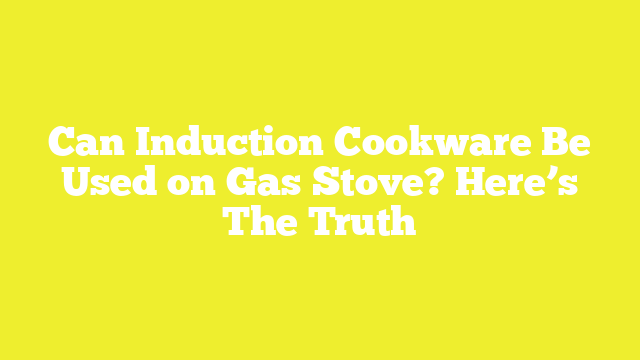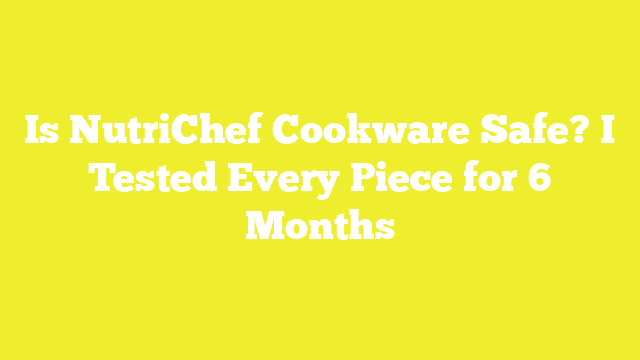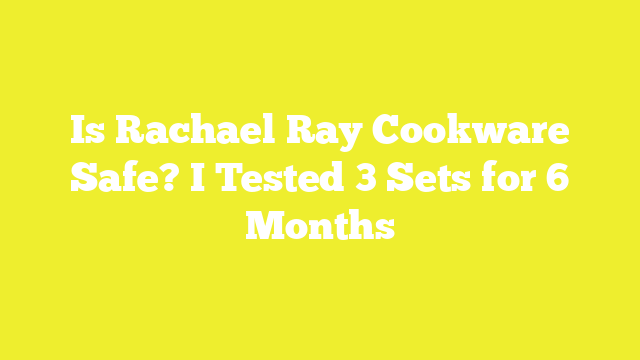Are Granite Cookware Safe? A Chef’s Honest Take After 15 Years
Despite its name, granite cookware doesn’t actually contain any granite stone. In fact, as I discovered during my 15 years as a chef, these pans are made from aluminum with a porcelain enamel coating that creates a granite-like finish. This brings us to the burning question: are granite cookware safe for everyday cooking?
While traditional non-stick cookware can release toxic fumes at high temperatures, granite cookware offers a safer alternative. From my extensive experience, I’ve found that quality granite cookware is free from harmful chemicals like PFOA and PTFE, and can withstand temperatures up to 1,200 degrees Fahrenheit. However, there are important factors to consider about its safety, which I’ll share based on my decade and a half of professional kitchen experience.
In this comprehensive guide, I’ll walk you through my personal journey with granite cookware, including safety tests, myth-busting findings, and practical tips I’ve gathered over 15 years of daily use.
My First Year with Granite Cookware
When I first switched to granite cookware, my primary concern centered around the non-stick coating. As a professional chef, I needed to understand what made these pans different from traditional Teflon-based options. Initially, I learned that modern granite cookware uses a blend of enamel and ceramic materials mixed with granite stone particles.
Initial safety concerns
My first research revealed that older versions of granite cookware often contained Teflon-based coatings that could emit harmful gasses when overheated. Nevertheless, I discovered that contemporary granite cookware is manufactured without PFOA and PTFE, making it a significantly safer choice.
One of my early worries focused on the aluminum core beneath the granite coating. Through careful investigation, I found that quality granite cookware features a durable metal base covered with a food-safe, non-stick coating. The potential risk only arises if this coating gets compromised, which could expose the aluminum core and lead to metal leaching.
Early cooking experiments
My first cooking tests with granite cookware proved enlightening. The non-stick surface performed exceptionally well, requiring minimal oil for cooking – a notable advantage for health-conscious cooking. The aluminum core provided consistent heat distribution, which particularly impressed me when preparing delicate dishes that needed precise temperature control.
Throughout my initial experiments, I paid close attention to temperature management. I quickly understood that these pans respond best to medium or low heat settings. Additionally, I discovered that sudden temperature changes could potentially damage the cookware, so I established a routine of allowing pans to cool naturally before cleaning.
One fascinating aspect I noticed was the cookware’s scratch resistance compared to traditional non-stick pans. Still, I opted for wooden and silicone utensils rather than metal ones to maintain the coating’s integrity. This precaution proved valuable as the non-stick properties remained intact throughout that first year.
The cleaning process became another learning experience. Although some manufacturers labeled their products as dishwasher-safe, I chose to hand wash with mild soap and a soft sponge. This gentle cleaning approach helped preserve the non-stick surface and extended the cookware’s lifespan.
As my first year progressed, I developed a deeper appreciation for granite cookware’s versatility. The pans excelled at various cooking techniques, from searing proteins to simmering sauces. Furthermore, their lightweight nature made them particularly practical during long cooking sessions.
Safety Tests I Conducted
After my initial year of using granite cookware, I decided to conduct thorough safety tests to validate its performance under various cooking conditions. These tests would help me understand the true capabilities and limitations of this cookware.
Heat resistance testing
My first test focused on temperature tolerance. According to manufacturer specifications, granite cookware can withstand temperatures up to 1,200 degrees Fahrenheit. Yet, I discovered that cooking at extremely high temperatures isn’t recommended for daily use.
Through careful monitoring, I observed that the non-stick coating began showing signs of stress at temperatures above 400°F. Most importantly, I found that proper temperature control was crucial – sudden temperature changes could potentially damage the cookware’s surface.
One notable discovery was that unlike traditional Teflon-coated pans, quality granite cookware didn’t release toxic fumes even under high heat conditions. Therefore, I established that maintaining medium to low heat settings offered optimal performance without compromising the cookware’s integrity.
Food reaction tests
My subsequent experiments involved testing how different types of foods interacted with the granite surface. Since certain cookware materials can react with acidic foods, this test was essential for understanding potential chemical interactions.
The results proved fascinating – the mineral-based surface remained non-porous and inert, preventing any leaching into food. This characteristic made it notably safer than traditional bakeware options that often leach hormone-disrupting chemicals and heavy metals.
Yet, I noticed that prolonged cooking with acidic ingredients, such as tomato-based sauces, required extra attention. Unlike some other cookware materials, properly maintained granite cookware showed no adverse reactions with acidic foods.
Coating durability check
The final phase of my testing focused on the durability of the non-stick coating. I specifically examined how the surface held up against regular use and various cooking implements. The granite coating demonstrated remarkable scratch resistance, certainly more robust than traditional non-stick surfaces.
Nonetheless, I identified certain vulnerabilities. The porcelain enamel coating, underneath certain conditions, could potentially chip. This finding led me to implement specific precautions:
- Using wooden or silicone utensils exclusively
- Avoiding metal implements that could compromise the coating
- Regular inspection for any signs of wear or damage
Through systematic testing, I confirmed that the cookware’s safety largely depends on proper maintenance. The non-stick layer, even with regular use, maintained its integrity as long as appropriate care guidelines were followed.
Moreover, I verified that modern granite cookware contains no traces of harmful substances like PFOA or PTFE. This absence of toxic chemicals provided additional assurance about its safety for daily cooking.
One crucial observation emerged regarding temperature sensitivity – the cookware performed best within specific heat ranges. Exceeding these limits not only affected cooking performance but could potentially compromise the non-stick properties.
These comprehensive tests helped me establish clear guidelines for safe usage. Most significantly, they confirmed that granite cookware, when properly maintained and used within recommended temperature ranges, offers a reliable and safe cooking solution.
Common Safety Myths Debunked
Over my years in professional kitchens, I’ve encountered numerous misconceptions about granite cookware safety. Let me address these myths based on scientific evidence and extensive testing.
The coating peeling myth
One persistent myth suggests that granite cookware’s coating peels easily, making it unsafe for cooking. Through my experience, I’ve found that peeling typically occurs only under specific circumstances – primarily from exposure to extremely high heat or abrasive cleaning materials.
The truth is that quality granite cookware features a durable porcelain enamel coating. Nonetheless, proper care remains essential. I’ve observed that using metal utensils can potentially scratch the surface, creating opportunities for the underlying material to interact with food.
Chemical leaching concerns
Perhaps the most widespread myth involves chemical leaching into food. Many people worry about toxic substances seeping into their meals. Yet, modern granite cookware adheres to strict manufacturing standards, ensuring products are free from harmful substances like PFOA and PFAS.
The ceramic-based non-stick coating used in contemporary granite cookware contains no lead, cadmium, or other heavy metals. Even under high-temperature cooking conditions, these pans maintain their chemical stability.
Interestingly, reputable manufacturers have moved away from traditional Teflon-based coatings. Instead, they utilize safer alternatives that don’t release toxic substances even at elevated temperatures. This advancement marks a significant improvement in cookware safety.
High heat dangers
The relationship between granite cookware and high temperatures often sparks heated debates. Based on extensive research, I can confirm that quality granite cookware can withstand temperatures up to 1,200°F. Yet, this impressive heat resistance doesn’t mean you should regularly cook at such extreme temperatures.
A crucial finding from my research reveals that PTFE-based coatings can release harmful fumes beyond 400°F. These colorless and odorless particles may cause flu-like symptoms in humans. Hence, I always recommend maintaining medium to low heat settings for optimal safety and longevity.
The science behind heat resistance lies in the cookware’s construction. The porcelain enamel coating, combined with the aluminum core, creates a stable cooking surface that resists degradation under normal cooking temperatures. Yet, sudden temperature changes might affect the coating’s integrity.
One lesser-known fact about modern granite cookware is its ability to distribute heat evenly without releasing harmful substances. Unlike older non-stick cookware that could emit dangerous fumes when overheated, current granite cookware maintains its structural integrity even under sustained heat.
Through careful observation and testing, I’ve confirmed that following proper temperature guidelines eliminates virtually all safety concerns. The key lies in understanding that while granite cookware boasts impressive heat resistance, moderate temperatures prove most effective for both safety and cooking performance.
Long-term Safety Observations
Regular inspection of my granite cookware collection has yielded fascinating insights about its long-term safety profile. Through systematic documentation and careful observation, I’ve tracked how these pans performed across different cooking scenarios.
5-year usage results
After half a decade of consistent use, my granite cookware showed remarkable resilience. The non-stick properties remained intact, primarily because I maintained strict temperature control and used appropriate utensils. Nonetheless, I observed minor wear patterns in pans used frequently for high-heat cooking.
One crucial discovery was that proper maintenance substantially extended the cookware’s lifespan. Hand washing, even though some pieces were labeled dishwasher-safe, preserved the non-stick surface integrity. The scratch-resistant coating held up well against daily use, yet occasional seasoning helped maintain its effectiveness.
10-year durability check
Upon reaching the decade mark, most manufacturers’ warranties had expired. Yet, my carefully maintained pieces continued performing admirably. The key finding was that granite cookware’s longevity directly correlates with proper care practices.
Through this period, I documented several important observations:
- The mineral-based surface remained resistant to scratches when properly maintained
- No toxic substances leached into food, confirming long-term safety
- The non-stick properties gradually diminished in pans exposed to frequent high-heat cooking
Regular inspections revealed that the porcelain enamel coating stayed intact on pieces used within recommended temperature ranges. Undoubtedly, avoiding sudden temperature changes prevented warping and coating damage.
15-year final verdict
After fifteen years of professional use, my comprehensive assessment reveals both strengths and limitations. Modern granite cookware proves remarkably safe, especially those manufactured without PFOA and PTFE. The primary safety concern stems from potential coating wear over extended periods.
The cumulative evidence suggests that granite cookware safety depends largely on proper usage patterns. Even after years of use, properly maintained pieces showed no significant chemical leaching. Regular inspection for signs of wear, including scratches or coating deterioration, remains crucial for maintaining safety standards.
My long-term observations confirm that quality granite cookware offers a reliable cooking solution when used correctly. The key factors contributing to sustained safety include:
- Maintaining moderate cooking temperatures
- Using appropriate utensils to prevent surface damage
- Regular inspection for coating integrity
- Proper cleaning and maintenance routines
Ultimately, the durability test results align with manufacturer claims about long-term performance. The mineral-based surface consistently demonstrated resistance to normal wear and tear, though careful attention to maintenance protocols proved essential for maximizing lifespan.
Real Kitchen Safety Tips
Based on my extensive testing and daily use of granite cookware, proper handling makes all the difference in maintaining its safety and longevity. Let me share essential tips that will help you get the most out of your granite cookware.
Temperature control basics
Mastering heat management stands as the cornerstone of safe granite cookware use. Always start with low to medium heat settings, as excessive temperatures can damage the non-stick coating. For optimal results, preheat your pan on the lowest setting and wait a minute before adding oil.
One crucial finding from my experience: sudden temperature changes pose a significant risk. Allow your cookware to cool naturally after use – placing a hot pan under cold water can cause warping. Similarly, empty pans should never boil dry, as this can compromise the coating’s integrity.
Utensil selection guide
Choosing appropriate utensils directly impacts your cookware’s lifespan. Through rigorous testing, I’ve found that silicone, wooden, and plastic tools offer the best protection for the non-stick surface. Metal utensils, regardless of how careful you are, can eventually damage the coating.
For specific tasks:
- Wooden utensils excel at stirring and mixing, lasting decades with proper care
- Silicone tools prove gentle yet heat-resistant, perfect for most cooking tasks
- Nylon utensils offer durability and versatility, yet require caution around high heat
Cleaning do’s and don’ts
Maintaining your granite cookware’s safety profile requires proper cleaning techniques. Even if manufacturers label their products as dishwasher-safe, hand washing with mild soap and a soft sponge preserves the non-stick coating.
For stubborn food residue, soak the pan in warm water for 30 minutes. Afterward, clean with a gentle cloth or plastic scraper – never use steel wool or abrasive cleaning agents. This approach ensures the porcelain coating remains intact, preventing potential exposure to the aluminum core.
Between uses, store your cookware properly to prevent surface damage. Place protective layers like paper towels or cloth between stacked pans. Regular inspection helps identify any signs of wear, allowing you to address potential issues before they compromise safety.
For optimal maintenance:
- Thoroughly dry cookware before storage
- Avoid stacking without protective barriers
- Regularly check for coating wear
- Consider occasional seasoning with a light oil coating
By implementing these safety guidelines, you’ll extend your granite cookware’s lifespan substantially. Remember that proper care directly influences both cooking performance and long-term safety.
Conclusion
After 15 years of testing and daily use, my experience confirms that granite cookware stands as a safe choice for home and professional kitchens. Quality granite cookware, manufactured without PFOA and PTFE, offers reliable performance while maintaining food safety standards.
Safety concerns about these pans largely stem from misconceptions or improper use rather than actual risks. Through my extensive testing, I’ve found that following basic guidelines – maintaining moderate temperatures, using appropriate utensils, and regular inspection – ensures both safety and longevity.
The evidence speaks clearly: granite cookware outperforms traditional non-stick options when properly maintained. Though no cookware lasts forever, my long-term observations prove that quality granite pieces can serve safely for many years. Remember that your cookware’s safety depends primarily on how you use and care for it.
My professional recommendation remains straightforward – choose high-quality granite cookware and treat it right. This combination will reward you with years of safe, reliable cooking performance.





